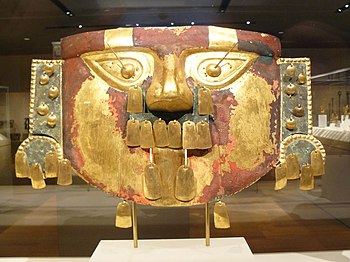How art speaks/ART103/Context
The decorative arts have meaning too, primarily in the functionality of the art works themselves, but also in the style and decorations afforded them. A goblet from the 17th century has an aesthetic meaning in its organic form, in its function as a means to hold and dispense liquid, and a particular historical meaning in the way it is embellished with diamond point engravings that depict the flow of the river Rhine (click ‘Fullscreen’ at the bottom of the image, and use the '+' tool to see the goblet in detail). The goblet’s detailed map of the Rhine gives it specific context: the historical, religious or social issues surrounding a work of art.
For the Sican people the mask represented either the Sican deity from the spiritual world or the lord of Sican, a man who represented the deity in the natural world. Masks were stacked at the feet of the dead lord in his tomb. In this cultural context the masks had significance in the life, death and spiritual worlds of the Sican people.
To view James Rosenquist’s painting F-111 is to be confronted with a huge image of a fighter jet overlaid with images from popular culture, all in bright colors and seemingly without connection.
- Full-scale view on exhibit at The Museum of Modern Art, hover over the image and select the plus signs to view details of each section
But when we see the work in the context of American experience in the 1960’s we realize the two-pronged visual comment Rosenquist is making about war and consumerism; what he termed “a lack of ethical responsibility”.[1] In the artist’s hands the two ideas literally overlap each other: the salon hair dryer and diver’s bubbles mimic the mushroom cloud rising behind the opened umbrella (which is another formal link to the nuclear bomb blast behind it). The painting is at such a large scale that viewers are dwarfed by its overpowering presence.
Contextual analysis concerns the issues and times of the making of the work of art. This involves the patrons and the art they wished to be made, the time of the community and the issues of the day.
Here is a description of the making of an Egyptian sculpture where we gain information of the making of the statue:
Sculptures of Akhenaten and his family break with long established conventions for depicting royal subjects. In numerous depictions, the figure of Akhenaten exhibits radically different proportions from those of previous kings. Images as the colossal figure of Akhenaten installed at the temple Amun-Ra in Karnak between 1355 and 1335 represent the king with narrow shoulders lacking musculature, with a marked pot belly, wide hips, and generous thighs. His large lips, distinctive nose and chin, and narrow eyes make his face recognizable. Scholars have found those unusual puzzling. Some dismiss the images as caricatures, yet such expensive and prominent images must have had the king’s approval. There have also been attempts to diagnose a medical condition rom those representations; the king’s features have been read as symptoms of Frolich’s Syndrome, a hormonal deficiency that produces androgynous characteristics. A more likely explanation is that his “feminized” appearance was intended to capture the androgynous fertile character of Aten as life-giver. The style was not restricted to the king’s image, but influenced representatives of court officials and others as well. [2]
In your journal, practice writing a contextual analysis of a work of art.
Notes
- ↑ Rosenquist, James (2009). Painting Below Zero: Notes on a Life in Art. Alfred A. Knopf. page 154.
- ↑ Janson’s History of Art: The Western Tradition,7th edition, vol.1 (New Jersey: Pearson/Prentice Hall), page 70.
